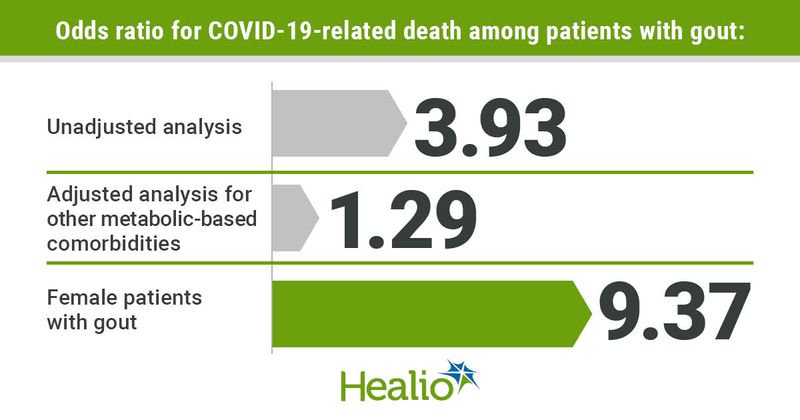Gout increases risk for COVID-19-related death
Click Here to Manage Email Alerts
Patients with gout demonstrate an increased risk for COVID-19-related death, with a greater burden in those with female vs. male sex, according to data published in The Lancet Rheumatology.
“COVID-19 outcomes for people with inflammatory rheumatic disease are becoming increasingly available,” Ruth K. Topless, BSc, of the University of Otago, in New Zealand, and colleagues wrote. “Within a cohort of 3,729 patients with rheumatic disease, the COVID-19 Global Rheumatology Alliance identified hypertension associated with cardiovascular disease and chronic lung disease as a comorbidity associated with COVID-19-related death, in addition to the established risk factors of older age and male sex.

“Despite its high prevalence (eg, 2.5% of the U.K. population), gout is underrepresented in the COVID-19 Global Rheumatology Alliance cohort, where it was included among in other inflammatory arthritis, which comprises only 2.6% of the cohort,” they added. “Our previous study in the U.K. Biobank cohort on outcomes for people with gout and COVID-19 comprised 2,059 individuals diagnosed with COVID-19 before Aug 25, 2020; our multivariable-adjusted analysis reported no evidence for gout as a risk factor for COVID-19-related death (odds ratio [OR] 1.2, 95% CI 0.8-1.7).”
To repeat their investigation into the potential association between gout and COVID-19 diagnosis and death, Topless and colleagues analyzed data from the U.K. Biobank, which included 15,871 patients with gout as of April 6, 2021. Information for the current study included hospital diagnoses from April 18, 1991, through May 7, 2021; SARS-CoV-2 tests between March 16, 2020, and April 6, 2021; and death records from May 10, 2006, to March 23, 2001. Patients missing a BMI, Townsend index score or smoking status were excluded from the analysis.
A total of 16,898 patients from the U.K. Biobank were identified to have had COVID-19. Among those, 1,111 patients died and 15,224 survived, while the status of 563 patients was unknown. In all, 840 patients with gout were diagnosed with COVID-19. Researchers used general practice prescription records to determine how many patients were prescribed colchicine and other urate-lowering therapies, with a single prescription being enough for inclusion. Additionally, linked data were used to determine which patients received vaccinations for COVID-19 and which vaccine they received.
The analysis included a total of 459,837 patients, of whom 15,871 had gout. In the time between March 5, 2020, and March 23, 2021, 0.9% of the patients with gout died with COVID-19, compared with 0.2% of patients in the entire study population. Patients with gout who died also demonstrated a higher proportion of metabolic-based diseases that are considered comorbidities, including chronic kidney disease and diabetes, the authors wrote.
Overall, gout was associated with a risk for death in the unadjusted analysis (OR = 3.93; 95% CI, 3.28-4.7). When adjusted for other diseases, gout was still associated with the risk of death with COVID-19 (OR = 1.29; 95% CI, 1.06-1.56). Additionally, female patients with gout had an increased risk of COVID-19-related death in the unadjusted analysis (OR = 9.37; 95% CI, 6.58-13.35).
“We found an increased risk of COVID-19-related death in people with gout, with a greater burden in women than men,” Topless and colleagues wrote. “Understanding the drivers of this increased risk in women with gout warrants further investigation in larger datasets.”

